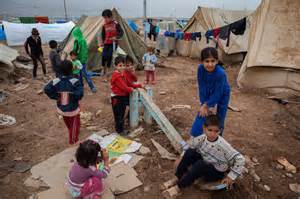The UN refugee agency has said that the record number of refugees, asylum seekers and internally displaced people globally is "a reflection of a world in chaos".
On the eve of World Refugee Day, the UN released a new report showing that the number of people forcibly displaced at the end of 2014 had risen to 59.5 million, compared with 51.2 million a year earlier and 37.5 million a decade ago.
June 20 has been marked by the UN as World Refugee Day since 2000 to honour those who are forced to flee their home countries under the threat of persecution, conflict and violence.
Globally, one out of every 122 people is now either a refugee, internally displaced or seeking asylum.
Melissa Fleming, UNHCR spokesperson, told Al Jazeera on Saturday that not nearly enough is being done globally to combat the unprecedented crisis.
"Displacement numbers at this scale are a reflection of a world in chaos, where the political leadership to stop and prevent conflicts is missing in action," she said.
"The old conflicts continue to fester unresolved and new conflicts continuously erupt. And humanitarian organisations are acutely underfunded.
"We fear that in 2015, at current forecasts, will have to make do with as much as $200m-$300m less than in 2015 because of currency fluctuations.
"This means we cannot meet even the basic needs of the millions of forcibly displaced people in desperate situations."
The large increase in displaced persons has primarily been driven by the war in Syria. Almost four million Syrians are now refugees, while a further 7.6 million are internally displaced, the UN says.
"The level of displacement and suffering is growing by the day [in Syria] and we fear it will get much worse before it gets better," Fleming said.
Afghanistan [2.59 million] and Somalia [1.1 million] are the next biggest refugee source countries.
Major new displacements have also been witnessed in Africa - mostly in the Central African Republic and South Sudan.
Overall, the largest refugee populations under UNHCR care are Afghans, Syrians and Somalis - together accounting for more than half of the global refugee total.
Meanwhile, Pakistan, Iran and Lebanon are hosting more refugees than other countries.
Internal displacement - people forced to flee to other parts of their country - now amounts to a record 33.3 million people, accounting for the largest increase of any group in the new UN report.
Among all those displaced globally, Fleming told Al Jazeera, more than half are children.
"We are particularly worried about a lost generation of Syrian children," she said.
"Inside Syria, their schools have been bombed or, living in displacement, they have no access to education. And refugee children face similar limitations. In Lebanon, for instance, only 20 percent of Syrian refugee children are in school."
The UN's new report also indicates growth in the numbers of refugees seeking safety through dangerous sea journeys, from the Mediterranean Sea and the Gulf of Aden to the Red Sea and the seas of Southeast Asia.
On the eve of World Refugee Day, the UN released a new report showing that the number of people forcibly displaced at the end of 2014 had risen to 59.5 million, compared with 51.2 million a year earlier and 37.5 million a decade ago.
June 20 has been marked by the UN as World Refugee Day since 2000 to honour those who are forced to flee their home countries under the threat of persecution, conflict and violence.
Globally, one out of every 122 people is now either a refugee, internally displaced or seeking asylum.
Melissa Fleming, UNHCR spokesperson, told Al Jazeera on Saturday that not nearly enough is being done globally to combat the unprecedented crisis.
"Displacement numbers at this scale are a reflection of a world in chaos, where the political leadership to stop and prevent conflicts is missing in action," she said.
"The old conflicts continue to fester unresolved and new conflicts continuously erupt. And humanitarian organisations are acutely underfunded.
"We fear that in 2015, at current forecasts, will have to make do with as much as $200m-$300m less than in 2015 because of currency fluctuations.
"This means we cannot meet even the basic needs of the millions of forcibly displaced people in desperate situations."
The large increase in displaced persons has primarily been driven by the war in Syria. Almost four million Syrians are now refugees, while a further 7.6 million are internally displaced, the UN says.
"The level of displacement and suffering is growing by the day [in Syria] and we fear it will get much worse before it gets better," Fleming said.
Afghanistan [2.59 million] and Somalia [1.1 million] are the next biggest refugee source countries.
Major new displacements have also been witnessed in Africa - mostly in the Central African Republic and South Sudan.
Overall, the largest refugee populations under UNHCR care are Afghans, Syrians and Somalis - together accounting for more than half of the global refugee total.
Meanwhile, Pakistan, Iran and Lebanon are hosting more refugees than other countries.
Internal displacement - people forced to flee to other parts of their country - now amounts to a record 33.3 million people, accounting for the largest increase of any group in the new UN report.
Among all those displaced globally, Fleming told Al Jazeera, more than half are children.
"We are particularly worried about a lost generation of Syrian children," she said.
"Inside Syria, their schools have been bombed or, living in displacement, they have no access to education. And refugee children face similar limitations. In Lebanon, for instance, only 20 percent of Syrian refugee children are in school."
The UN's new report also indicates growth in the numbers of refugees seeking safety through dangerous sea journeys, from the Mediterranean Sea and the Gulf of Aden to the Red Sea and the seas of Southeast Asia.


No comments:
Post a Comment